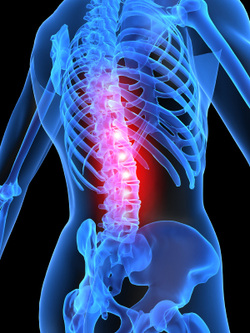Back Pain

At some point in their lives almost all individuals will suffer from back pain. In fact, in any given month, an astounding forty-three percent of the population suffers from some form of back pain.
Back pain can be an acute or chronic condition - and it is often caused by accidents, strain, disease, normal wear and tear, and even bad posture. Individuals who are more likely to suffer from back pain include pregnant women, smokers, and individuals that lift heavy items on a regular basis.
Back pain is the most common reason for seeking the services of a chiropractor. More specifically, lower back pain is the most cited reason for seeing a chiropractor.
Sciatica: One of the most common causes of lower back pain is sciatica – a condition whereby the sciatic nerve, the longest nerve in the body, becomes inflamed. The pain from this condition can vary from a constant throbbing pain to an intense knife-like pain. Luckily, chiropractic spinal adjustments can take the stresses off the associated spinal discs and nerves. In turn, the spinal adjustments allow the body to function in a more effective manner.
Upper Back Pain: Many individuals do seek out chiropractor care for upper back pain – which basically is any pain that people feel between the top of the lumbar spine and the bottom of the neck. Some causes of upper back pain include compression of the vertebra and spinal disc herniation (more commonly incorrectly referred to as a “slipped disc”).
Scoliosis: Another cause of back pain is scoliosis or curvature of the spine. Scoliosis affects approximately two percent of the population and it is more prevalent among females than males. As scoliosis does put undo stress on the spine, chiropractors can aid in relieving this stress through spinal adjustments.
Chiropractic Treatments Are BeneficialAccording to recent scientific literature, chiropractic treatments are by far the most effective way to improve the quality of life for individuals suffering from chronic back pain. Specifically, a 2003 American Medical Association publication, the Journal of the Spine, reported that chiropractic care was five times more effective than treatment with Vioxx or Celebrex. Numerous studies also reveal that people who do visit a chiropractor for their back pain are more satisfied with chiropractic treatments than with traditional medical care.
The treatment chiropractors perform, spinal adjustments, relieves stress on the associated discs and nerves which helps alleviate the back pain. Once the pain is relieved, individuals, naturally, can be mobile once again.
Since bed rest may cause further injury to the back, seeing a chiropractor is especially advantageous for this reason alone. Additionally, when people visit chiropractors for back pain they can avoid undergoing back surgery and taking medication. Both of these treatments for back pain are risky and costly to the individual and insurance providers alike.
And besides being ineffective at relieving back pain for the long term, individuals may suffer side effects from prescription drugs that can include steroids, muscle relaxants, and opioid drugs. Some of these side effects may include fatigue, nausea, depression, gastrointestinal injury, and decreased bone mass.
Back pain can be an acute or chronic condition - and it is often caused by accidents, strain, disease, normal wear and tear, and even bad posture. Individuals who are more likely to suffer from back pain include pregnant women, smokers, and individuals that lift heavy items on a regular basis.
Back pain is the most common reason for seeking the services of a chiropractor. More specifically, lower back pain is the most cited reason for seeing a chiropractor.
Sciatica: One of the most common causes of lower back pain is sciatica – a condition whereby the sciatic nerve, the longest nerve in the body, becomes inflamed. The pain from this condition can vary from a constant throbbing pain to an intense knife-like pain. Luckily, chiropractic spinal adjustments can take the stresses off the associated spinal discs and nerves. In turn, the spinal adjustments allow the body to function in a more effective manner.
Upper Back Pain: Many individuals do seek out chiropractor care for upper back pain – which basically is any pain that people feel between the top of the lumbar spine and the bottom of the neck. Some causes of upper back pain include compression of the vertebra and spinal disc herniation (more commonly incorrectly referred to as a “slipped disc”).
Scoliosis: Another cause of back pain is scoliosis or curvature of the spine. Scoliosis affects approximately two percent of the population and it is more prevalent among females than males. As scoliosis does put undo stress on the spine, chiropractors can aid in relieving this stress through spinal adjustments.
Chiropractic Treatments Are BeneficialAccording to recent scientific literature, chiropractic treatments are by far the most effective way to improve the quality of life for individuals suffering from chronic back pain. Specifically, a 2003 American Medical Association publication, the Journal of the Spine, reported that chiropractic care was five times more effective than treatment with Vioxx or Celebrex. Numerous studies also reveal that people who do visit a chiropractor for their back pain are more satisfied with chiropractic treatments than with traditional medical care.
The treatment chiropractors perform, spinal adjustments, relieves stress on the associated discs and nerves which helps alleviate the back pain. Once the pain is relieved, individuals, naturally, can be mobile once again.
Since bed rest may cause further injury to the back, seeing a chiropractor is especially advantageous for this reason alone. Additionally, when people visit chiropractors for back pain they can avoid undergoing back surgery and taking medication. Both of these treatments for back pain are risky and costly to the individual and insurance providers alike.
And besides being ineffective at relieving back pain for the long term, individuals may suffer side effects from prescription drugs that can include steroids, muscle relaxants, and opioid drugs. Some of these side effects may include fatigue, nausea, depression, gastrointestinal injury, and decreased bone mass.
